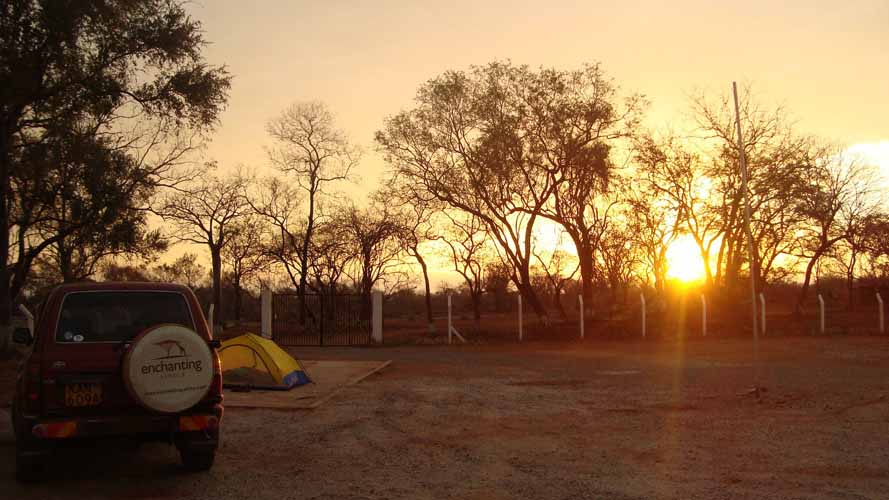
After almost 10 weeks travelling through Southern and Eastern Africa, we are on the home stretch and I am writing this story from the Mozambiquen-Tanzanian border on the Rovuma River.
We are in absolute No Mans' Land – 180km of rough 4x4 road from the nearest Mozambiquen town, Mueda, and 100km of dirt road from the nearest Tanzanian town, Masasi and until two days ago, we didn't fully understand how to cross the mighty Rovuma River over to Tanzania because nobody who we asked could tell us, as no one seems to have ever crossed this border. Some told us about a new bridge, others about loading the car on two canoes that are tied together and act as a makeshift ferry. Not surprisingly, we didn't meet a single vehicle on the 180 km from Mueda, and when we arrived at the Mozambiquen side of the river last night two hours after sunset, there was – nothing! Nothing except pitch black darkness as the moon hadn't risen yet and we could only see some lights on the far Tanzanian side of the river. We didn't quite make it to the river before the border closed and therefore had to camp overnight on the Mozambiquen side, a lonely Mozambiquen soldier allowed us to pitch our tent right in front of the immigration building. This didn't, however, solve our question of where to get some food as we hadn't eaten since breakfast and when we asked our soldier (seemingly, there was only this one soldier to secure the Mozambiquen border) what to do about this, he allowed us to cross over on foot to the Tanzanian side to get some food there. So, we approached what looked like a monstruous sight in the darkness and walked for about 1km over the bridge towards the scattered lights on the Tanzanian side, occasionally looking down trying to recognize the features of the river below.
Reaching the Tanzanian side of the bridge, we first encountered a couple of love birds who had chosen the solitude to the bridge and a bit later were suddenly stopped by a Tanzanian soldier who emerged out of the darkness to question what we were doing. We explained that empty stomachs had caused us to embark on our night border crossing and fully understanding this motivation he pointed to some lights where he said we would be able to get some food. We thoroughly enjoyed the local food in the company of some local youth and several truck drivers and afterwards returned the way we had come, back over the Ponte de Unidade or Unity Bridge.
 Now, the sun is up and we can see the huge bridge spanning the wide river – it is not quite clear to me why this bridge was build in such No Mans' Land, 200km inland from the coast, instead of building it on the coast allowing a more direct connection between the coastal Tanzanian and coastal Mozambiquen road. Also, the lack of border traffic appears to have resulted in a very relaxed attitude of the Mozambiquen immigration and customs personnel towards border opening and closing times. An hour after the official opening time of the border, there is still no one in sight - this gives me the time to write this story and to reflect on this trip...
Now, the sun is up and we can see the huge bridge spanning the wide river – it is not quite clear to me why this bridge was build in such No Mans' Land, 200km inland from the coast, instead of building it on the coast allowing a more direct connection between the coastal Tanzanian and coastal Mozambiquen road. Also, the lack of border traffic appears to have resulted in a very relaxed attitude of the Mozambiquen immigration and customs personnel towards border opening and closing times. An hour after the official opening time of the border, there is still no one in sight - this gives me the time to write this story and to reflect on this trip...
10 weeks of travelling by road through Africa, the first 3 weeks from Nairobi to South Africa, via Tanzania, Malawi, Zambia, Botswana and Zimbabwe, then one month in South Africa, following the German team during the World Cup, and now 3 weeks back from South Africa to Nairobi, crossing the entire length of Mozambique. The purpose of this journey was threefold – exploring the beauty of Southern Africa, enjoying the Soccer World Cup in South Africa and laying the ground work for the Enchanting-Africa expansion to Malawi, Mozambique, Zambia, Zimbabwe, Botswana and South Africa.
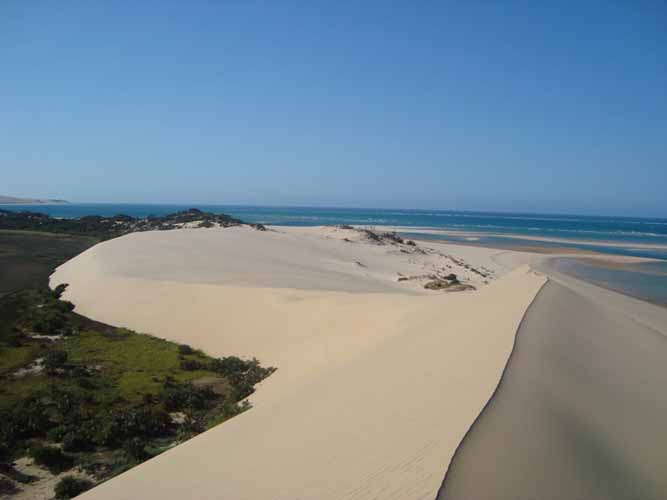 An amazing trip that has brought us to countless beautiful places - the deep blue waters of Lake Malawi, floating in a canoe past hippos on the mighty Zambezi river, getting drenched at the awe-inspiring Victoria Falls, watching hundreds of elephants drink and play at sunset on the banks of the Chobe River, discovering the once and hopefully soon again popular Hwange and Matopos National Parks in Zimbabwe, experiencing the spectacular and ever changing landscapes of South Africa, seeing Leopards on a night game drive in Sabi Sands, diving with Great White Sharks in the Western Cape and cruising with Southern Right Whales in Kwa Zulu Natal, behaving like a teenager after Germany beating England 4:1 and Argentina 4:0, skiing in the mountains of Lesotho, climbing the dunes and enjoying the incredible views and colour contrasts in the stunning Bazaruto Archipelago in Southern Mozambique, enjoying the picture postcard beaches and turquoise sea on tiny Medjumbe Island and dancing the night away in a local disco on Ibo Island in the Quirimbas Archipelago in Northern Mozambique.
An amazing trip that has brought us to countless beautiful places - the deep blue waters of Lake Malawi, floating in a canoe past hippos on the mighty Zambezi river, getting drenched at the awe-inspiring Victoria Falls, watching hundreds of elephants drink and play at sunset on the banks of the Chobe River, discovering the once and hopefully soon again popular Hwange and Matopos National Parks in Zimbabwe, experiencing the spectacular and ever changing landscapes of South Africa, seeing Leopards on a night game drive in Sabi Sands, diving with Great White Sharks in the Western Cape and cruising with Southern Right Whales in Kwa Zulu Natal, behaving like a teenager after Germany beating England 4:1 and Argentina 4:0, skiing in the mountains of Lesotho, climbing the dunes and enjoying the incredible views and colour contrasts in the stunning Bazaruto Archipelago in Southern Mozambique, enjoying the picture postcard beaches and turquoise sea on tiny Medjumbe Island and dancing the night away in a local disco on Ibo Island in the Quirimbas Archipelago in Northern Mozambique.
Through Tanzania and Malawi
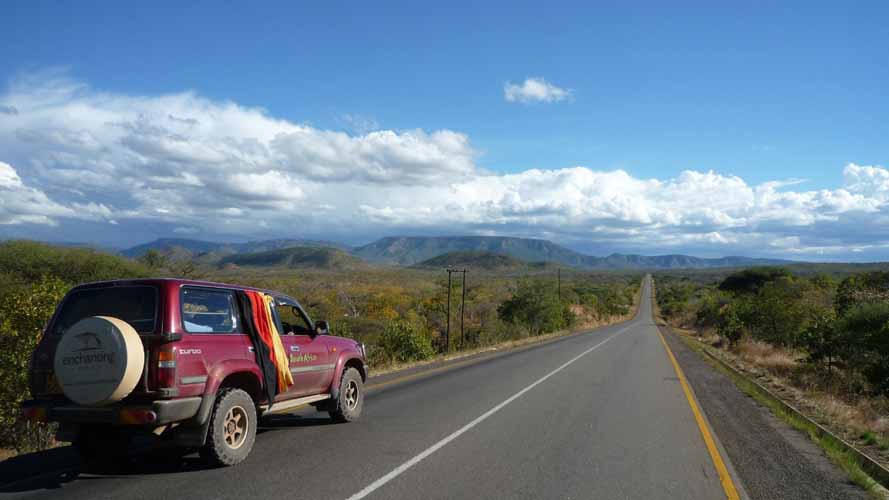 Our journey started in Nairobi on a clear morning in mid May and, with several Germany flags flying out of the windows of the recently purchased Landcruiser we looked like being on the way to a high profile Bundesliga match as we cruised towards the Tanzanian border and enjoyed the beautiful views of Mt Kilimanjaro and Mt Meru.
Our journey started in Nairobi on a clear morning in mid May and, with several Germany flags flying out of the windows of the recently purchased Landcruiser we looked like being on the way to a high profile Bundesliga match as we cruised towards the Tanzanian border and enjoyed the beautiful views of Mt Kilimanjaro and Mt Meru.
In the next five days we crossed through Tanzania, with stops in the scenic Usambara Mountains in northern Tanzania, the dramatic Uluguru Mountains in central Tanzania, the beautiful Southern Highlands where we enjoyed horse riding through the green carpeted tea plantations and in the bustling town of Mbeya in South Western Tanzania.
On the fourth day of our journey, we started what would become a sincere effort to find the least capable auto garage in Eastern and Southern Africa. Our Landcruiser had developed a disturbing habit of overheating and over the next couple of weeks, we were amazed by the range of solutions which different auto mechanics were able to come up with in order to stop the overheating problem. Even more amazing was the self-confidence with which each one of them sent us on our way ensuring us that from now on, we would not have any problems any more – promises we desperately believed until the Landcruiser would show signs of overheating 100-150 kilometers later. Should any of the readers of this article experience overheating problems with their car, we encourage you to contact us – we will surely be able to tell you which solutions do not work. Surprisingly, even the official Toyota dealer in Johannesburg was not able to fix the problem (even though they charged us heftily) and it was not until we passed through a small coastal village in Northern Mozambique on the way back to Nairobi more than two months later that an ingenious mechanic achieved what at this point we would happily describe as a miracle.
From Mbeya, we drove to the northern end of Lake Malawi and spent a night in a quaint guesthouse at a secluded sandy beach in breathtaking surroundings, with mountains plunging right into the blue waters of Lake Malawi. We so much enjoyed the pristine beauty of this place where we felt like being at the end of the world that we were tempted to spend a couple of nights there - until our first lunch of dry fish and rice. After lunch, we asked the waiter if we could have dinner as well to which he agreed enthusiastically. Our next question related to the options for dinner, and when he – equally enthusiastically – responded that we could have "fish and rice", we realized that this was going to be the only option available as long as we would stay here. This eased our decision to continue further south and, thus, we were on our way crossing the border to Malawi on the next morning.
 Malawi bills itself as the "warm heart of Africa" and driving through the countryside, the people we met lived up to our expectations – we were amazed to find out that in Malawi, even the policemen were polite when they stopped us on the road, usually asking us about the strange black, red and yellow striped flags flying from our car windows which due to our Kenyan number plate they believed to be the Kenyan flag. As soon as we told them that we were on our way to the soccer world cup in South Africa, they would either immediately tell us which team was going to win the tournament or ask us if they could come along with us to South Africa. Thus, our journey along the stunning Lake Malawi was a pleasant one, with stops at Chintheche on the central lakeshore and a couple of days at the southern end of the lake whose picturesque islands and crystal clear waters we explored by boat, kayak and a traditional dhow.
Malawi bills itself as the "warm heart of Africa" and driving through the countryside, the people we met lived up to our expectations – we were amazed to find out that in Malawi, even the policemen were polite when they stopped us on the road, usually asking us about the strange black, red and yellow striped flags flying from our car windows which due to our Kenyan number plate they believed to be the Kenyan flag. As soon as we told them that we were on our way to the soccer world cup in South Africa, they would either immediately tell us which team was going to win the tournament or ask us if they could come along with us to South Africa. Thus, our journey along the stunning Lake Malawi was a pleasant one, with stops at Chintheche on the central lakeshore and a couple of days at the southern end of the lake whose picturesque islands and crystal clear waters we explored by boat, kayak and a traditional dhow.
Saying good bye to Lake Malawi, we moved on to Liwonde National Park, the premier game park in Malawi where we experienced interesting game drives, bush walks and particularly enjoyed a boat safari on the Shire River, passing hippos, crocodiles, elephants and various species of antelopes at the edge of the river.
Onwards to Zambia and Botswana
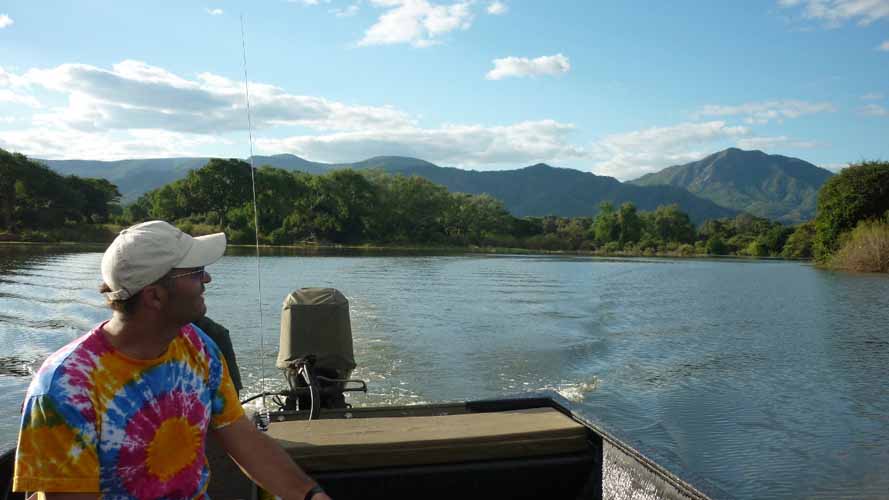 Driving via Lilongwe, we then crossed the border to Zambia where our first highlight was Lower Zambezi National Park in the dramatic Zambezi Valley. Following our desire to get to know a couple of safari lodges, we set out on an afternoon boat excursion 50 kilometers downriver where we visited several lodges before heading back just before sunset – much too late as we would soon realize. What was a 1 hour boat cruise downstream in the pleasantly warm afternoon sun earlier in the day, turned – due to the strong current of the Zambezi - into a 3 hour cruise upstream in excruciatingly cold evening temperatures. Dressed only in T-shirts and shorts, we were quietly freezing and hoping to see the lights of our lodge behind each bend in the river, only to be disappointed time and again. Just before we had settled at the thought that we were going to freeze to death during a boat cruise on the Zambezi River in the heart of Africa, we finally arrived at the lodge whose manager was utterly surprised we were not overly excited about the idea of a dinner under the stars and instead insisted on having a hot shower in order to warm up first.
Driving via Lilongwe, we then crossed the border to Zambia where our first highlight was Lower Zambezi National Park in the dramatic Zambezi Valley. Following our desire to get to know a couple of safari lodges, we set out on an afternoon boat excursion 50 kilometers downriver where we visited several lodges before heading back just before sunset – much too late as we would soon realize. What was a 1 hour boat cruise downstream in the pleasantly warm afternoon sun earlier in the day, turned – due to the strong current of the Zambezi - into a 3 hour cruise upstream in excruciatingly cold evening temperatures. Dressed only in T-shirts and shorts, we were quietly freezing and hoping to see the lights of our lodge behind each bend in the river, only to be disappointed time and again. Just before we had settled at the thought that we were going to freeze to death during a boat cruise on the Zambezi River in the heart of Africa, we finally arrived at the lodge whose manager was utterly surprised we were not overly excited about the idea of a dinner under the stars and instead insisted on having a hot shower in order to warm up first.
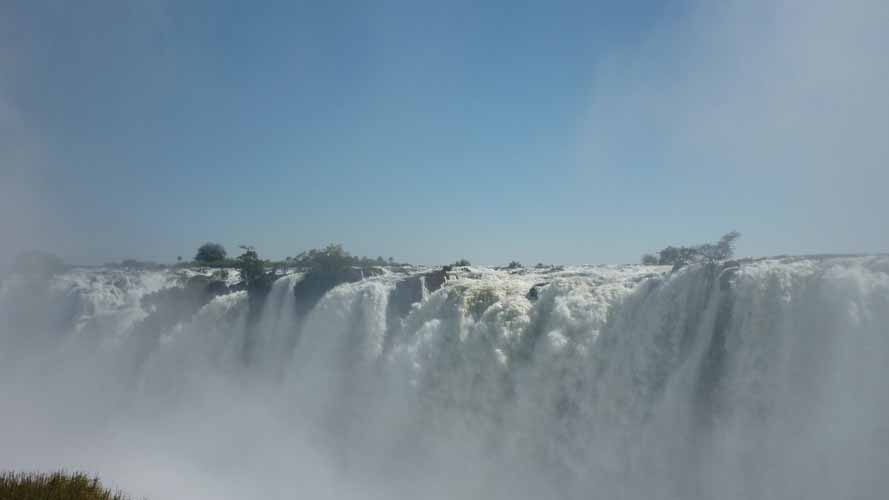 The next morning, we embarked on a far more pleasant canoe excursion on the Zambezi, a wonderful experience of silently gliding along the riverbanks and past small islands in the river, encountering hippos, elephants and buffalo at very close distances.
The next morning, we embarked on a far more pleasant canoe excursion on the Zambezi, a wonderful experience of silently gliding along the riverbanks and past small islands in the river, encountering hippos, elephants and buffalo at very close distances.
After our adventures in Lower Zambezi, we headed on to the mighty Victoria Falls which due to the high water level of the Zambezi were particularly spectacular. The spray from the falls was so dense that walking along the opposite side of the falls had the same effect as entering a power shower – whatever rain protection we were wearing, we ended up being soakingly wet after our falls visit. To get a full appreciation of the dimensions of this world wonder, we decided to take a helicopter ride over the falls and enjoyed fantastic views of the Zambezi River, the falls and the dramatically winding gorge below.
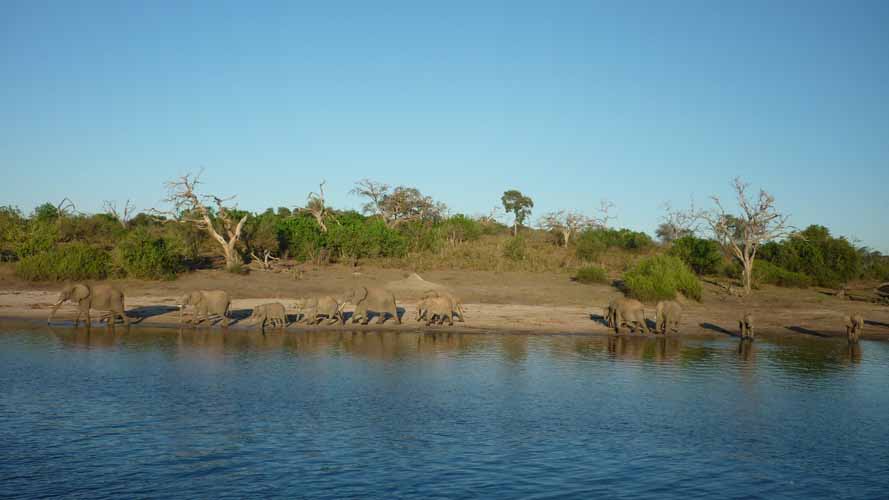 While we were heading south to Zimbabwe, we could not resist the temptation of a short detour to Botswana and to Chobe National Park where we stayed at the Zambezi Queen, a stylishly designed floating hotel on the Chobe River. Here, we experienced one of the highlights of our journey – a sunset boat cruise on the Chobe. Getting up close to kudu, giraffe, hippo and crocodiles and watching hundreds of elephants drinking, playing and cavorting at the water's edge as the evening sun painted the scenery in a golden light was one of my most memorable safari experiences ever.
While we were heading south to Zimbabwe, we could not resist the temptation of a short detour to Botswana and to Chobe National Park where we stayed at the Zambezi Queen, a stylishly designed floating hotel on the Chobe River. Here, we experienced one of the highlights of our journey – a sunset boat cruise on the Chobe. Getting up close to kudu, giraffe, hippo and crocodiles and watching hundreds of elephants drinking, playing and cavorting at the water's edge as the evening sun painted the scenery in a golden light was one of my most memorable safari experiences ever.
Through Zimbabwe to the Soccer World Cup
Heading on to Zimbabwe, our first stop was Hwange National Park where we spent two nights and experienced fantastic game 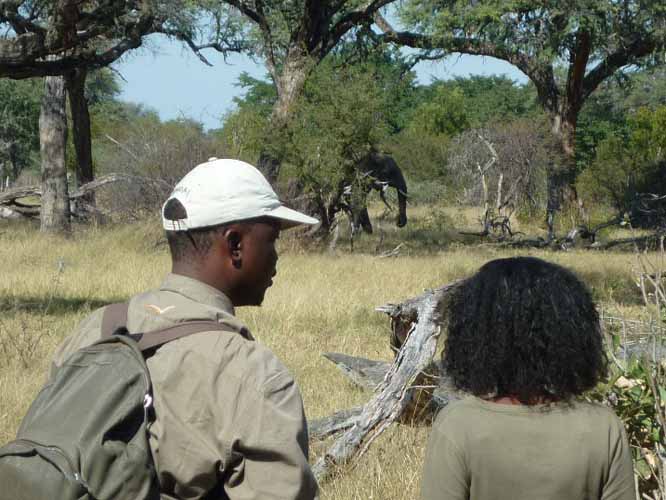 drives and even more spectacular walking safaris, once again discovering that Zimbabwe has the best safari guides in Africa whose knowledge, experience and passion turned our close encounters with buffalo, lions and elephants into particularly memorable experiences.
drives and even more spectacular walking safaris, once again discovering that Zimbabwe has the best safari guides in Africa whose knowledge, experience and passion turned our close encounters with buffalo, lions and elephants into particularly memorable experiences.
We would have liked to stay longer in Zimbabwe, but time was running out as we had to be in Durban for the first match of the German national team against Australia a couple of days later and therefore, we continued our journey with one overnight stop in the scenic Matopos National Park where giants appear to have piled up huge boulders into bizaar rock formations.
We reached South Africa on June 11, the day on which the Soccer World Cup started, and arriving on this day was a memorable experience in itself - all South African immigration and customs officers were dressed in the shirts of Bafana Bafana, the South African soccer team, and in Messina, the South African border town, the sides of the road were lined with people, all equally dressed in Bafana Bafana outfits and competing in making the loudest possible noise with their Vuvuzelas. The excitement about the World Cup finally having come to Africa was very touching and remembering these moments, arriving in South Africa on the day the Soccer World Cup kicked off, still creates a subtle shudder down my spine.

We only had two days to cross from the northernmost point of South Africa to Durban to make it to the first match of the German team on June 13 and so we made good use of the terrific South African highways, only stopping for a night en-route in Johannesburg. Durban greeted us with its magnificent sea front which had been turned into a party zone for soccer supporters from around the world and locals alike. Spending the day before the Germany-Australia match on the beach front convinced us that Durban was firmly in Australian control as German supporters were easily outnumbered by their Australian counterparts who showed a great sense of sportsmanship and humour after the young German team put on an impressive performance that night.
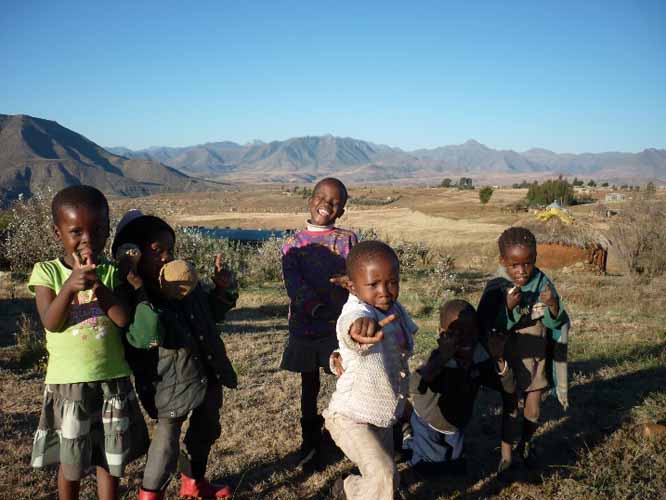 Over the course of the next four weeks, I travelled two full circles through South Africa following the German team during the World Cup and experiencing the beautiful Garden Route, the stunning Blyde River Canyon, the vast and striking Karoo and its smaller sister, the Little Karoo, bustling Cape Town, the endless deserted beaches in Kwa Zulu Natal and the spectacular mountains of Lesotho. Here, I went on a beautiful pony trek in serene mountain country and couldn't resist the temptation to ski at "Afriski", the only ski resorts in Southern Africa that has snow making facilities. After twice skiing down the 500 meter ski slope, I concluded that South Africa will have difficulty competing with Austria and Switzerland and continued my journey to the breathtaking Drakensberg Mountains.
Over the course of the next four weeks, I travelled two full circles through South Africa following the German team during the World Cup and experiencing the beautiful Garden Route, the stunning Blyde River Canyon, the vast and striking Karoo and its smaller sister, the Little Karoo, bustling Cape Town, the endless deserted beaches in Kwa Zulu Natal and the spectacular mountains of Lesotho. Here, I went on a beautiful pony trek in serene mountain country and couldn't resist the temptation to ski at "Afriski", the only ski resorts in Southern Africa that has snow making facilities. After twice skiing down the 500 meter ski slope, I concluded that South Africa will have difficulty competing with Austria and Switzerland and continued my journey to the breathtaking Drakensberg Mountains.
Along the Indian Ocean back from South Africa to Nairobi
 After watching the final of the Soccer World Cup in Johannesburg on July 11, we started our long journey back to Kenya, a journey of more than 6000kilometers largely along the Indian Ocean coast. The most intriguing places on this journey were the strikingly beautiful Bazaruto Archipelago in Southern Mozambique, the not yet rediscovered Gorongosa National Park in Central Mozambique which appears to be on the way to reach its former glory, Ilha de Mozambique where we felt like embarking on a journey back in time through the history of Eastern Africa and Arabia, the fantastic and undiscovered beaches and reefs at Memba Bay, the only place on the East African Coast where snorkelling and diving is possible right from the beach, and the tiny islands surrounded by pristine corral reefs and turquoise water in the remote Quirimbas Archipelago in northern Mozambique. One of our most memorable moments on our entire journey was the Friday night disco on quaint Ibo Island in the Quirimbas - dancing with the locals under the stars and next to a mango tree right next to the beach was almost surreal and an experience I will never forget.
After watching the final of the Soccer World Cup in Johannesburg on July 11, we started our long journey back to Kenya, a journey of more than 6000kilometers largely along the Indian Ocean coast. The most intriguing places on this journey were the strikingly beautiful Bazaruto Archipelago in Southern Mozambique, the not yet rediscovered Gorongosa National Park in Central Mozambique which appears to be on the way to reach its former glory, Ilha de Mozambique where we felt like embarking on a journey back in time through the history of Eastern Africa and Arabia, the fantastic and undiscovered beaches and reefs at Memba Bay, the only place on the East African Coast where snorkelling and diving is possible right from the beach, and the tiny islands surrounded by pristine corral reefs and turquoise water in the remote Quirimbas Archipelago in northern Mozambique. One of our most memorable moments on our entire journey was the Friday night disco on quaint Ibo Island in the Quirimbas - dancing with the locals under the stars and next to a mango tree right next to the beach was almost surreal and an experience I will never forget.
I look back to these last ten weeks and am grateful for having had the opportunity to embark on this journey, which was great fun and has given me an appreciation and understanding of Southern Africa.
Beyond the places visited, I met many interesting people and countless moments will stay with me - many evenings under the stars that triggered philosophical or just obscure thoughts and questions, such as the question of how many stars there are and how many sandcorns there are on earth. During one evening under the stars, we made an earnest attempt to quantify the latter – the figure we calculated is 50,000 quadrillion sandcorns on earth.
I challenge all of you to come up with a more accurate figure!

